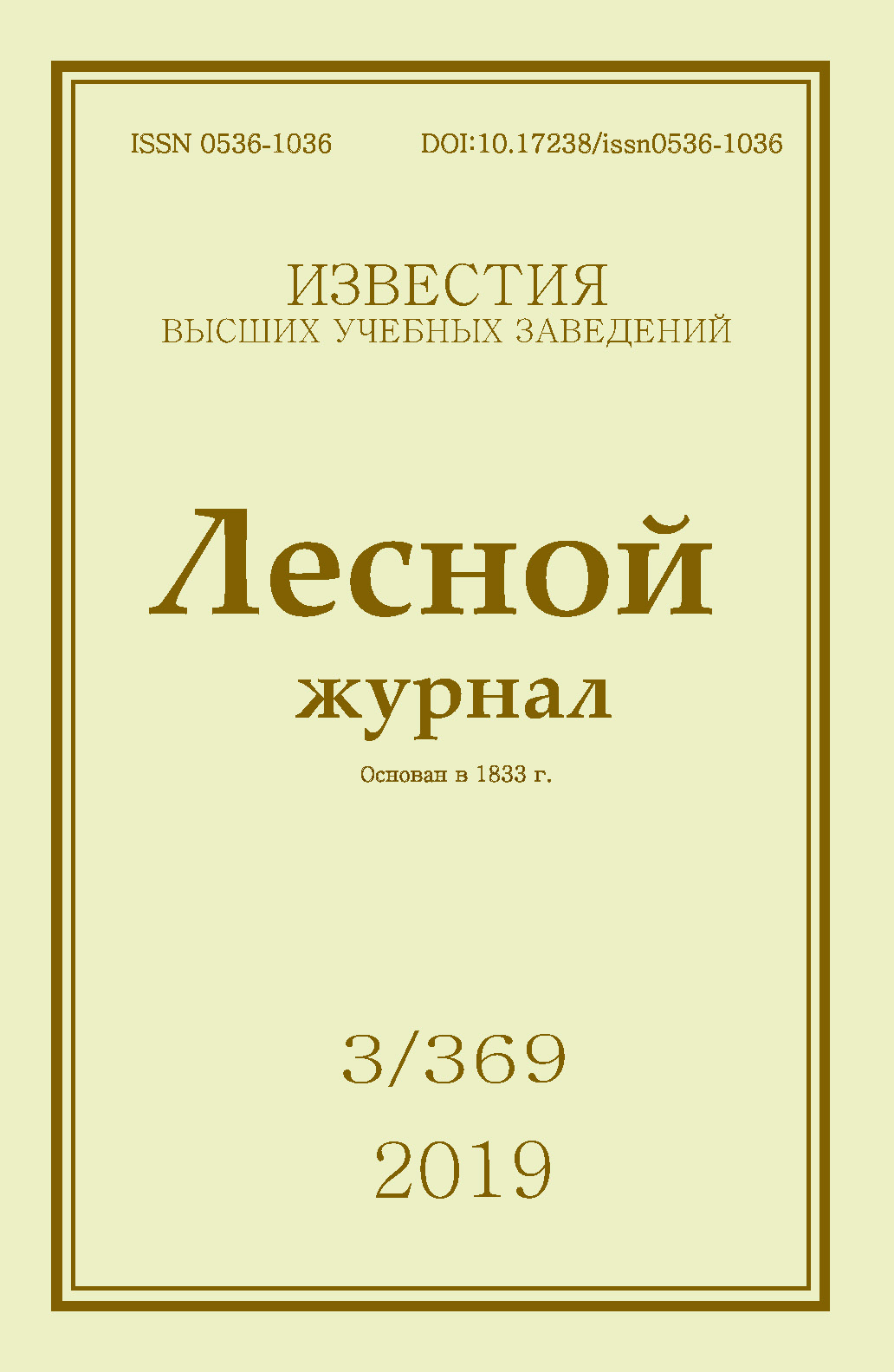Formation of Floodplain Forest Biogeocenosis Litter with the Participation of Acer negundo L.
DOI:
https://doi.org/10.17238/issn0536-1036.2019.3.73Keywords:
box elder, phytogenic field, plant litter, phytomass, phenolic compounds, ligninAbstract
The article presents the results of the influence of box elder (Acer negundo L.) litterfall on the forest litter formation in floodplain forest communities. The research object was plant litter collected from different sites of phytogenic fields of A. negundo natural stands growing in the floodplain of the Tom River. Sampling was carried out according to the three types of crown density. The outer zone of scattered trees was chosen as a control sample. The vegetation cover was described, and the dominant plant species and their total projective cover were determined within the subcrown, near-front and outer zones of the tree phytogenic field. Just before the research analytical samples were isolated; they were dried to air-dry condition and weighed in order to determine the proportion of each plant fraction. Content of polyphenolic compounds and lignin was determined in the samples. The results’ analysis had shown that the crown density of Acer negundo L. population, as well as the content of mineral and organic compounds of plant litter, influences the formation of floodplain forest communities’ litter. The most intensive mineralization of litter in the soil, especially in the subcrown zone, is found under scattered trees in sparse woodland. Probably this is due to the increased content of nutrients and total absorbed bases, as well as a higher phytomass accumulation, and minimum content of polyphenols and lignin, in comparison with the forest litter of trees from the other studied groups. The research results can be used for the monitoring of natural ecosystems.
For citation: Tsandekova O.L., Ufimtsev V.I. Formation of Floodplain Forest Biogeocenosis Litter with the Participation of Acer negundo L. Lesnoy Zhurnal [Forestry Journal], 2019, no. 3, pp. 73–81. DOI: 10.17238/issn0536-1036.2019.3.73
Funding: The research was carried out within the framework of the state assignment of the Federal Research Center of Coal and Coal Chemistry of the Siberian Branch of the RAS (project no. 0352-2019-0015)
Downloads
References
Адрианов С.Н., Сушеница Б.А. Роль фосфора в современном земледелии // Плодородие. 2004. № 3(18). С. 13–16. 2. Гамзиков Г.П. Азот в земледелии Западной Сибири. М.: Наука, 1981. 267 с.
ГОСТ 26177–84. Корма, комбикорма. Метод определения лигнина. М.: Изд-во стандартов, 1984. 3 с.
ГОСТ Р 54650–2011. Почвы. Определение подвижных соединений фосфора и калия по методу Кирсанова в модификации ЦИНАО. М.: Стандартинформ, 2013. 11 с.
Гродзинский А.М. Аллелопатия в жизни растений и их сообществ: Основы химического взаимодействия растений. Киев: Наук. думка, 1965. 198 с.
Долгих Е.А., Кавеленова Л.М. Особенности химического состава опада дуба и липы в зависимости от комплекса лесорастительных условий // Химия растительного сырья. 1999. № 4. С. 25–29.
Ковалева Н.О., Ковалев И.В. Биотрансформация лигнина в лесных почвах // Лесоведение. 2006. № 3. С. 57–63.
Коренская И.М., Ивановская Н.П., Измалкова И.Е. Лекарственные растения и лекарственное растительное сырье, содержащие антраценпроизводные, простые фенолы, лигнаны, дубильные вещества. Воронеж: ИПЦ Воронеж. ГУ, 2007. 87 c.
Самаров В.М. Почвы и климат Кузнецкой котловины: учеб. пособие. Кемерово: ГСХИ, 2017. 79 с.
Чульдиене Д., Алейниковиене Ю., Мурашкиене М., Марозас В., Армолайтис К. Распад и сохранность органических соединений и питательных элементов в лиственном опаде после зимнего сезона под лесопосадками лиственницы европейской, бука обыкновенного и дуба красного в Литве // Почвоведение. 2017. № 1. С. 56–63. DOI: 10.7868/S0032180X16110022
Шелепова О.В., Возна Л.И. Сравнительная оценка влияния опада древесных растений на свойства дерново-подзолистых почв дендрария ГБС РАН // Бюл. ГБС. 2016. № 1(202). С. 22–26.
Austin A.T., Ballaré C.L. Dual Role of Lignin in Plant Litter Decomposition in Terrestrial Ecosystems // PNAS. 2010. Vol. 107, no. 10. Pp. 4618–4622. DOI: 10.1073/pnas.0909396107
Balemi T., Negisho K. Management of Soil Phosphorus and Plant Adaptation Mechanisms to Phosphorus Stress for Sustainable Crop Production: A Review // Journal of Soil Science and Plant Nutrition. 2012. Vol. 12, iss. 3. Pp. 547–561. DOI: 10.4067/S0718-95162012005000015
DeAngelis K.M., Allgaier M., Chavarria Y., Fortney J.L., Hugenholtz Ph., Simmons B., Sublette K., Silver W.L., Hazen T.C. Characterization of Trapped Lignin-Degrading Microbes in Tropical Forest Soil // PLoS ONE. 2011. Vol. 6, iss. 4, article no. e19306. DOI: 10.1371/journal.pone.0019306
Kara O., Bolat I., Cakıroglu K., Senturk M. Litter Decomposition and Microbial Biomass in Temperate Forests in Northwestern Turkey // Journal of Soil Science and Plant Nutrition. 2014. Vol. 14, iss. 1. Pp. 31–41. DOI: 10.4067/S0718-95162014005000003
Lamarque L.J., Delzon S., Lortie Ch.J. Tree Invasions: A Comparative Test of the Dominant Hypotheses and Functional Traits // Biological Invasions. 2011. Vol. 13, iss. 9. Pp. 1969–1989. DOI: 10.1007/s10530-011-0015-x
Polyakova O., Billor N. Impact of Deciduous Tree Species on Litterfall Quality, Decomposition Rates and Nutrient Circulation in Pine Stands // Forest Ecology and Management. 2007. Vol. 253, iss. 1–3. Pp. 11–18. DOI: 10.1016/j.foreco.2007.06.049
Porté A.J., Lamarque L.J., Lortie Ch.J., Michalet R., Delzon S. Invasive Acer negundo Outperforms Native Species in Non-Limiting Resource Environments Due to Its Higher Phenotypic Plasticity // BMC Ecology. 2011. Vol. 11, article no. 28. DOI: 10.1186/1472-6785-11-28
Saccone P., Pagès J.Ph., Girel J., Brun J.-J., Michalet R. Acer negundo Invasion along a Successional Gradient: Early Direct Facilitation by Native Pioneers and Late Indirect Facilitation by Conspecifics // New Phytologist. 2010. Vol. 187, iss. 3. Pp. 831–842. DOI: 10.1111/j.1469-8137.2010.03289.x
Wang Q., Wang S., Huang Y. Comparisons of Litterfall, Litter Decomposition and Nutrient Return in a Monoculture Cunninghamia lanceolata and a Mixed Stand in Southern China // Forest Ecology and Management. 2008. Vol. 255, iss. 3–4. Pp. 1210–1218. DOI: 10.1016/j.foreco.2007.10.026







